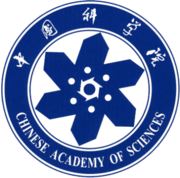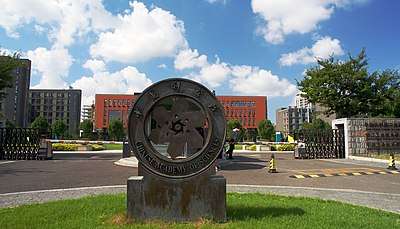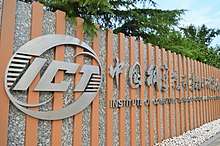Chinese Academy of Sciences
The Chinese Academy of Sciences (CAS; Chinese: 中国科学院) is the national academy for the natural sciences of the People's Republic of China. It has historical origins in the Academia Sinica during the Republican era and was formerly also known by that name. Collectively known as the "Two Academies (两院)" along with the Chinese Academy of Engineering, it functions as the national scientific think tank and academic governing body, providing advisory and appraisal services on issues stemming from the national economy, social development, and science and technology progress. It is headquartered in Xicheng District, Beijing,[1] with branch institutes all over mainland China. It has also created hundreds of commercial enterprises, Lenovo being one of the most famous.
| 中国科学院 | |
 | |
| Agency overview | |
|---|---|
| Formed | 1949 |
| Headquarters | Beijing, China |
| Agency executive |
|
| Parent agency | State Council of China |
| Website | english |
| Chinese Academy of Sciences | |||||||||||||||
|---|---|---|---|---|---|---|---|---|---|---|---|---|---|---|---|
| Simplified Chinese | 中国科学院 | ||||||||||||||
| Traditional Chinese | 中國科學院 | ||||||||||||||
| |||||||||||||||
It is the world's largest research organisation, comprising around 60,000 researchers working in 114 institutes,[2][3] and has been consistently ranked among the top research organisations around the world.[4][5][6]
The Chinese Academy of Sciences has been consistently ranked the No. 1 research institute in the world by Nature Index since its inception in 2016, by Nature Research.[7]
Organization
.jpg)
The Chinese Academy originated in the Academia Sinica founded, in 1928, by the Republic of China. After the Communist Party took control of mainland China, the residual of Academia Sinica was renamed Chinese Academy of Sciences (CAS),while others relocated to Taiwan.
The Chinese Academy of Sciences has six academic divisions:
- Chemistry (化学部)
- Information Technological Sciences (信息技术科学部)
- Earth Sciences (地学部)
- Life Sciences and Medical Sciences (生命科学和医学学部)
- Mathematics and Physics (数学物理学部)
- Technological Sciences (技术科学部)
The CAS has thirteen regional branches, in Beijing, Shenyang, Changchun, Shanghai, Nanjing, Wuhan, Guangzhou, Chengdu, Kunming, Xi'an, Lanzhou, Hefei and Xinjiang. It has over one hundred institutes and two universities (the University of Science and Technology of China at Hefei, Anhui and the University of the Chinese Academy of Sciences in Beijing). Backed by the institutes of CAS, UCAS is headquartered in Beijing, with graduate education bases in Shanghai, Chengdu, [Wuhan, Guangzhou and Lanzhou, four Science Libraries of Chinese Academy of Sciences, three technology support centers and two news and publishing units. These CAS branches and offices are located in 20 provinces and municipalities throughout China. CAS has invested in or created over 430 science- and technology-based enterprises in eleven industries including eight companies listed on stock exchanges.
Being granted a Fellowship of the Academy represents the highest level of national honor for Chinese scientists. The CAS membership system includes Academicians (院士), Emeritus Academicians (荣誉院士) and Foreign Academicians (外籍院士).
- Current President: Bai Chunli
Research reputation and ranking
The Chinese Academy of Sciences was ranked #1 in the 2016, 2017, 2018 and 2019 Nature Index Annual Tables, which measure the largest contributors to papers published in 82 leading journals.[8][9][10][11]
List of presidents
- 1949–1978: Guo Moruo
- 1979–1981: Fang Yi
- 1981–1987: Lu Jiaxi
- 1987–1997: Zhou Guangzhao
- 1997–2011: Lu Yongxiang
- 2011–present: Bai Chunli
Academy members
Membership of the Chinese Academy of Sciences (also known by the title Academician (CAS), Chinese: 中国科学院院士) is a lifelong honour given to Chinese scientists who have made significant achievements in various fields. According to Bylaws for Members of the Chinese Academy of Sciences adopted in 1992 and recently amended in 2014, it is the highest academic title in China. A formal CAS member must hold Chinese citizenship, although foreigners can be elected as foreign members of CAS. Members older than 80 are designated as "senior members", and may no longer hold leading positions in the organization.[12] Academicians of the Chinese Academy of Sciences carry an obligation to advance science and technology, to advocate and uphold scientific spirit, to develop a scientific and technological workforce, to attend member meetings and receive consultation and evaluation tasks, and to promote international exchanges and cooperation. Academicians can give suggestions and influence Chinese state policy related to science and technology.[13]
Research institutes


- Beijing Branch
- University of the Chinese Academy of Sciences (UCAS)
- Academy of Mathematics and Systems Science
- Institute of Acoustics (IOA)
- Institute of Atmospheric Physics
- Institute of Botany, Chinese Academy of Sciences
- Institute of Physics (IOPCAS)
- Institute of Semiconductors
- Institute of Electrical Engineering (IEE)
- Institute of Information Engineering (IIE)
- Institute of Theoretical Physics
- Institute of High Energy Physics
- Institute of Biophysics
- Institute of Genetics and Developmental Biology
- Institute of Electronics
- National Astronomical Observatories
- Institute of Computing Technology
- Institute of Software
- Institute of Automation
- Beijing Institute of Genomics
- Institute of Geographic Sciences and Natural Resources
- Institute of Geology and Geophysics (IGG)
- Institute of Remote Sensing and Digital Earth
- Institute of Tibetan Plateau Research
- Institute of Vertebrate Paleontology and Paleoanthropology
- National Center for Nanoscience and Technology
- Institute of Policy and Management
- Institute of Psychology
- Institute of Zoology
- Changchun Branch
- Changchun Institute of Optics, Fine Mechanics and Physics
- Changchun Institute of Applied Chemistry
- Northeast Institute of Geography and Agroecology
- Changchun Observatory
- Chengdu Branch
- Institute of Mountain Hazards and Environment
- Chengdu Institute of Biology
- Institute of Optics and Electronics
- Chengdu Institute of Organic Chemistry
- Institute of Computer Application
- Chongqing Institute of Green and Intelligent Technology
- Guangzhou Branch
- South China Botanical Garden
- Shenzhen Institutes of Advanced Technology
- South China Sea Institute of Oceanology
- Guangzhou Institute of Energy Conversion
- Guangzhou Institute of Geochemistry
- Guangzhou Institute of Biomedicine and Health
- Guiyang Branch
- Institute of Geochemistry
- Hefei Branch
- Kunming Branch
- Lanzhou Branch
- Institute of Modern Physics
- Lanzhou Institute of Chemical Physics
- Lanzhou Institute of Geology
- Northwest Institute of Plateau Biology
- Northwest Institute of Eco-Environment and Resources
- Qinghai Institute of Salt Lakes Research
- Nanjing Branch
- Purple Mountain Observatory (Zijinshan Astronomical Observatory)
- Institute of Soil Science
- Nanjing Institute of Geology and Palaeontology
- Nanjing Institute of Geography and Limnology
- Nanjing Institute of Astronomical Optics and Technology
- Suzhou Institute of Nano-tech and Nano-bionics (SINANO)
- Suzhou Institute of Biomedical Engineering and Technology (SIBET)
- Nanjing Botanical Garden, Memorial Sun Yat-Sen (Institute of Botany, Jiangsu Province and Chinese Academy of Science)
- University of Chinese Academy of Sciences, Nanjing College
- Shanghai Branch
- Shanghai Astronomical Observatory
- Shanghai Institute of Microsystem and Information Technology
- Shanghai Institute of Technical Physics
- Shanghai Institute of Optics and Fine Mechanics
- Shanghai Institute of Ceramics
- Shanghai Institute of Organic Chemistry
- Shanghai Institute of Applied Physics
- Shanghai Institutes for Biological Sciences
- Shanghai Institute of Materia Medica
- Institut Pasteur of Shanghai [14]
- Shanghai Advanced Research Institute, CAS
- Institute of Neuroscience (ION)[15][16]
- ShanghaiTech University
- Shenyang Branch
- Institute of Metal Research
- Shenyang Institute of Automation
- Shenyang Institute of Applied Ecology, formerly the Institute of Forestry and Pedology
- Shenyang Institute of Computing Technology
- Dalian Institute of Chemical Physics
- Qingdao Institute of Oceanology
- Qingdao Institute of Bioenergy and Bioprocess Technology
- Yantai Institute of Coastal Zone Research
- Taiyuan Branch
- Shanxi Institute of Coal Chemistry (ICCCAS)
- Wuhan Branch
- Wuhan Institute of Rock and Soil Mechanics
- Wuhan Institute of Physics and Mathematics
- Wuhan Institute of Virology
- Institute of Geodesy and Geophysics
- Institute of Hydrobiology
- Wuhan Botanical Garden
- Xinjiang Branch
- Xinjiang Technical Institute of Physics and Chemistry
- Xinjiang Institute of Ecology and Geography
- Xi'an Branch
- Xi'an Institute of Optics and Precision Mechanics
- National Time Service Center
- Institute of Earth Environment
Scientific integrity
On 26 February 2007, CAS published a Declaration of Scientific Ideology and set up a commission for scientific integrity to promote transparency, autonomy and accountability of scientific research in the country. The Ministry of Science and Technology had at the same time also initiated measures to address misconduct in state-funded programs.[17]
Publications
| Language | English |
|---|---|
| Standard abbreviations | |
| ISO 4 | Sci. China |
Together with the National Natural Science Foundation of China, the academy publishes the peer-reviewed academic journal, Science China (also known as Science in China). Science China comprises seven series:[18]
- A: Mathematics
- B: Chemistry
- C: Life Sciences
- D: Earth Sciences
- E: Technological Sciences
- F: Information Sciences
- G: Physics, Mechanics and Astronomy
CAS also promotes the China Open Access Journals (COAJ) platform,[19] a national variant of the international Directory of Open Access Journals (DOAJ).
Awards
Since 1999 the CAS has issued the annual State Preeminent Science and Technology Award, presented by the President of China to the recipient.[20]
See also
- Academia Sinica
- Chinese Academy of Engineering
- Chinese Academy of Social Sciences
- Chinese Science Citation Database
- Hanlin Academy
- History of science and technology in the People's Republic of China
- International Journal of Software and Informatics (IJSI)
- International Society of Zoological Sciences
- Legend Holdings
- Science and technology in China
- Scientific publishing in China
- Shanghai Academy of Social Sciences
- ShanghaiTech University
- University of Chinese Academy of Sciences
- University of Science and Technology of China
References
Citations
- "Contact." Chinese Academy of Sciences. Retrieved on May 31, 2018. "Add: 52 Sanlihe Rd., Xicheng District, Beijing, China Postcode: 100864" - Address in Chinese: "地址:北京市三里河路52号 邮政编码:100864"
- "Ten institutions that dominated science in 2015".
- Cao, Cong (2015). UNESCO Science Report (PDF). Paris: UNESCO. pp. 621–641. ISBN 978-92-3-100129-1.
- "Nature Global Institutions Ranking, 2013–2014". Nature. 522 (7556): S34–S44. 2015. doi:10.1038/522S34a. ISSN 0028-0836.
- "Nature Global Institutions Ranking, 2016 tables".
- "Nature Index". natureindex.com.
- "Nature Index". Retrieved 31 July 2019.
- "Ten institutions that dominated science in 2015". Retrieved 28 May 2019.
- "Nature Index Annual Tables 2017". Retrieved 28 May 2019.
- "10 institutions that dominated science in 2017". Retrieved 28 May 2019.
- "Introduction to the Nature Index". Retrieved 28 May 2019.
- "中国科学院院士章程 [Bylaws for Members of the Chinese Academy of Sciences]". Chinese Academy of Sciences. Retrieved 16 September 2014.
- "Obligations and Rights of a CAS Member". Academic Divisions of the Chinese Academy of Sciences. Retrieved 16 September 2014.
- "中国科学院上海巴斯德研究所", 维基百科,自由的百科全书 (in Chinese), 7 March 2020, retrieved 28 June 2020
- Cyranoski, David (24 January 2018). "First monkeys cloned with technique that made Dolly the sheep". Nature. 553 (7689): 387–388. Bibcode:2018Natur.553..387C. doi:10.1038/d41586-018-01027-z. ISSN 0028-0836. PMID 29368720.
“This paper really marks the beginning of a new era for biomedical research,” says Xiong Zhi-Qi, a neuroscientist who studies brain disease at the Chinese Academy of Sciences Institute of Neuroscience (ION) in Shanghai.
- "Director's Introduction". Institute of Neuroscience. Retrieved 25 January 2018.
As part of a major drive for excellence in basic research in the new millennium, the Chinese Academy of Sciences founded the Institute of Neuroscience (ION) on November 27, 1999.
- The Lancet (17 March 2007). "Reforming research in China". The Lancet. 369 (9565): 880. doi:10.1016/S0140-6736(07)60419-X. PMID 17368128.
- "Science in China Press".
- "China in Brief – Science and Technology – Awards". China Internet Information Center (State Council Information Office and the China International Publishing Group). Retrieved 21 November 2012. Cite journal requires
|journal=(help)
Sources
